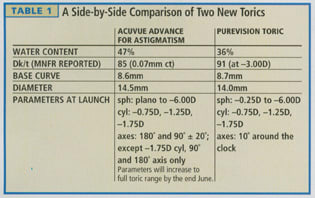contact lens materials
Toric CLs: the Next Phase of
Silicone Hydrogel Materials
BY LORETTA B. SZCZOTKA-FLYNN, OD, MS, FAAO
At last, silicone hydrogel toric contact lenses are here! I know that contact lens practitioners around the world read this journal and that this may be old news to some of you, but in the United States, this modality is brand new. Vistakon has just released its Acuvue Advance for Astigmatism contact lens and Bausch & Lomb's PureVision Toric will soon follow (this lens has been available in Europe and in Canada). CIBA Vision will release its O2Optix Toric later this year. Let's take a look at what the immediate future has in store for us in the way of toric silicone hydrogel contact lenses.
Just Imagine the Possibilities
What an exciting opportunity to share with our astigmatic patients: either up to a 30-day continuous wear option or simply higher oxygen transmissibility for daily wear. Toric contact lenses have long suffered from significantly lower oxygen transmission, particularly when manufactured in prism-ballasted designs. With the incorporation of silicone hydrogel contact lens materials, corneal hypoxia will no longer pose a concern (that is, as long as patients fit into the available parameters). Just think: I may even be able to fit some of my post-transplant patients in soft contact lenses!
Toric Designs and Materials
Those of us who fit silicone hydrogel contact lens materials are no strangers to these toric silicone hydrogel materials.
B&L manufactures its PureVision Toric in balafilcon A and in the same "Lo-Torque" design that it employs in its SofLens66 Toric. It will; however, slightly adjust the design for its PureVision Toric to accommodate the higher modulus of the balafilcon material.
Vistakon manufactures its Acuvue Advance for Astigmatism in galyfilcon A. The company will use the lens to introduce an "Accelerated Stabilization Design" that boasts a controlled lid/lens interaction with an accelerated slope of thickness across four lens zones. Thin zones rest under the open eyelid and thick zones rest outside the open eyelid.
At launch, both lenses will have limited parameters (see Table 1), but they'll quickly expand to full ranges.
Go Ahead -- Include Astigmats
Contact lens practitioners should offer all of their patients the increased oxygen transmissibility that silicone hydrogel contact lenses provide -- and now, astigmats are no exception. This is the next step in making this lens option mainstream.

Dr. Szczotka-Flynn is an associate professor at Case Western Reserve University Dept. of Ophthalmology and is director of the Contact Lens Service at University Hospitals of Cleveland.\



